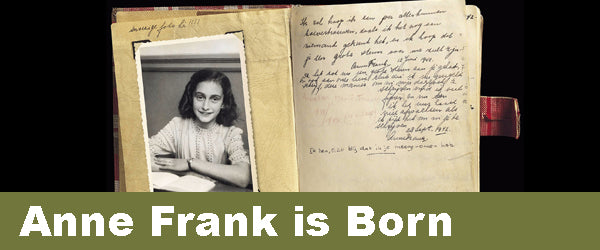
Posted by The Home School in the Woods Team on
June 12, 1929, is the birthday of a young teen who left an extraordinary mark on history.
Anne Frank was a Jewish girl who lived in Germany during World War II. Although Anne (along with many other Jewish people) would live a complicated life because of the Nazi regime, she continued to have a hopeful spirit, as seen in the diary she left behind.
In this post, we’ll talk about the life of Anne and our tips on how you can teach your kids about difficult subjects such as the life of Anne Frank and the Holocaust.
Who Is Anne Frank?
Anneliese Marie Frank (1929 - 1945) was born in Frankfurt, Germany, to Edith Hollander Frank and Otto Frank, who was a Jewish business owner.
In 1933, when Anne was four years old, Adolf Hitler became the chancellor of Germany and began his plan called the “Final Solution,” a policy that sought to persecute Jewish citizens living in Germany.
When Anne’s sister, Margot, was sent a letter ordering her to go and work for a camp in Germany, her mother and father decided to put the family in hiding, located behind a bookcase that led up to an attic above her father’s business.
A week into hiding, they were joined by one of Otto Frank’s Jewish colleagues, Hermann van Pels, his wife Auguste, and their son, Peter. They would later be joined by Fritz Pfeffer, the Jewish dentist of Miep Gies, who was responsible for bringing the families food and supplies while in hiding.
Although they lived in a small space and were constantly in fear of being heard by the warehouse workers below, the group managed to spend a little over two years in hiding.
To pass the time, Anne would write in a diary she received for her 13th birthday. Her journal entries, which she addressed to her imaginary friend called “Kitty,” helped her express her feelings about being a teenage Jewish victim.
Although Anne’s diary was filled with drama – such as her crush on Peter, fights with her mother, and frustrations with her sister – she also discussed adult struggles such as being human in a dark world, religion, and politics.
When Did Anne Frank Die?
On August 4, 1944, German police discovered the secret annex, and they were arrested. The group was then split and sent to various concentration camps throughout Germany.
Perhaps you’re wondering, “how did Anne Frank die?”.
Anne and her sister Margot were spared from going to Auschwitz, a camp notorious for their gas chambers, and instead were sent to Bergen-Belsen, where they would die in February from what many believe had been typhus.
Even though the war would end in September of that year, the camp wouldn’t be found by British soldiers until just a few weeks after the Frank sisters’ death in April.
As for other members of the group, Anne’s mother died in January of 1945 from starvation at Auschwitz. Hermann van Pels died shortly after his arrival at Auschwitz in 1944, and his son Peter in 1945 at a camp in Austria.
Although they are unsure about Hermann’s wife, she is said to have died in a camp in Czechoslovakia the same year as her son. Fritz Pfeffer died from illness at a camp in 1944.
The only survivor of the group was Anne’s father, Otto, who was liberated from a camp in Auschwitz in 1945.
Life and Legacy of Anne Frank
After Otto was released from the concentration camp, his caretaker during hiding, Miep Gies, gave him a stack of papers she found in the annex written by Anne.
Since Anne’s dream was to become a writer, he decided to publish her diary as a way for the public to understand what life was like under Nazi government control.
Anne Frank’s book, The Diary of a Young Girl, became a sensation and sold over 10 million copies. Today, it is a required reading assignment in many schools around the world.
Anne Frank’s diary is on display in the Anne Frank House in Amsterdam, which is the building which she and her family hid in for 25 months.
Teaching About Anne Frank to Your Children
Discussing the Holocaust can be a challenging subject for kids to learn about – let alone the parents who have to explain it.
As a homeschool parent, we’re confident you know whether or not your child is mature enough to emotionally handle learning about such weighty subjects in history such as this.
Our recommendations are to prepare them for what they’re going to be learning about ahead of time and following up their studies with comforting Bible verses to help them remember God’s perspective on racism, justice, and love.
Anne Frank Learning Materials
At Home School in the Woods, we try our best to make sure our studies are objective, historically focused, and kid-friendly so that children can emotionally comprehend hard topics in history.
We believe “Living Books,” like Anne Frank’s Diary and The Red Ribbon, are wonderful tools to help children emotionally grasp the topic of the Holocaust. There are also several meaningful Anne Frank quotes that are worth reading.
If your kids like learning subjects through hands-on projects, be sure to check out our World War II Time Travelers, which covers who Anne Frank was and what life was like for Jewish people during World War II.
Remembering Anne Frank!
Even though Anne Frank died at the age of 15, she certainly lived a memorable life worth honoring. We’re sure Anne would be pleased to know her book is being read all across the world in several different languages.
For more This Week in History posts, don’t forget to follow us on Facebook or Instagram!
Share this post
- 0 comment
- Tags: Living Books, World History
